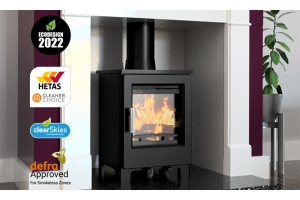
Modern wood burning stoves provide low carbon, low pollution and are a great source of renewable and sustainable fuels.
Due to a lack of awareness, caused mostly by mainstream media, wood burning stoves are incorrectly being victimised though as a negative way to efficiently fuel your home.
In truth a modern wood burning stove provides both low carbon and low emissions when combined with environmentally & sustainable fuel.
A common misconception is this idea that wood burning stoves are the biggest cause of small particulate matter in the UK.
A release by Defra’s Clean Air Strategy claimed that domestic combustion accounted for 38% of all fine particulate matter. However this number was generated based on inaccurate and outdated 2015 government surveys.
This same survey also exaggerated just how many stoves were in the UK.
A further and more accurate study carried out in 2019 actually showed that the figure was much closer to 13% than 38%, less than a ⅓ of the quoted figure from 2015. It is also worth noting that this doesn’t include the more modern ecodesigned compliant wood burning stoves that emit around 66% than 2015 appliances.
Something else that also contributed to this figure was other sources of PM2.5, such as bonfires and incinerators that produce vast amounts more PM2.5 then a stove.
A popular myth that has been published a few times in mainstream media, is the fabrication that wood burning stoves create the same emissions as 18 diesel cars. A somewhat exaggerated claim.
Comparing two different appliances that run at very different efficiency levels is grossly unfair.
An example is the car was measured running at just 21mph compared to the wood burning stove that burnt at its normal run rate.
This study failed to take into comparison things such as car brakes, its tyres and included measurement of the emissions just from the cars exhaust pipe.
A random fact is that there is greater emissions generated from a car's tyres and brakes then its exhaust back.
Another thing that was overlooked too was the difference in dispersal points of both the cars and the wood stoves.
The way a car outputs its emissions, via the exhaust pipe is at face level whilst a wood burning stove, emits its emissions well past any realistic human height.
Commenting on the study Morley Sage, chair of the Stove Industry Alliance said “This view fails to take into account the huge advances that have been made by the woodburning stove industry in recent years.
“Many critics of woodburning stoves base their assumptions on data linked to open fires, older stoves and poor-quality wood fuel.
“The SIA would be one of the first organisations to point out that burning wet wood on an open fire, a practice that is still very common today, is one of the least efficient and most highly polluting ways to heat your home.
“By contrast, a modern wood burning stove emits up to 90% less emissions than an open fire and up to 80% less than a stove that is 10 or more years old.”





